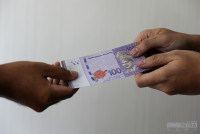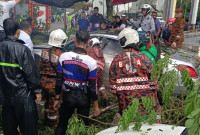MALAYSIAN street food and passion for our culinary traditions run in our veins. Just take a peek at social media sites dedicated to Malaysians abroad. You will most likely find that the conversation usually revolves around where one can find the best nasi lemak or wantan mee. And then the disappointment when the sambal is actually ketchup or the wantan noodles costs a sinful £7 (RM38).
For many, if not most Malaysians, a meal at the sanitised and orderly stalls and restaurants of our food and culinary nemesis, Singapore, is hardly comparable to the taste, smells and chaos of Malaysia’s authentic street food.
So how did the small island state pull the rug from under our feet and that of other larger neighbours in the region to get ‘Singapore’s Hawker Culture’ inscribed on the United Nations Educational, Scientific and Cultural Organisation (Unesco) Representative List of Intangible Cultural Heritage (ICH) of Humanity?
Singapore claims the nomination focuses on the ‘Singapore Hawker Culture Experience’. It contributes to the ‘Singaporean Identity’ meant to focus on hawker culture in the Singapore context. The republic even came up with its tagline and campaign to counter the hostility from its neighbours. It stated: “Let's all keep calm and carry on pledging our support,” – a seemingly meek pre-emptive strike.
Singapore, in defence over the criticisms of it hijacking a shared heritage, claimed that the listing of the island’s hawker culture did not mean that it originates or exists only in Singapore.
In its application, the city-state briefly acknowledged similarities of its hawker culture with neighbouring countries. “Similar food practices and food centres can be found in neighbouring countries and internationally, each with respective historical contexts, cultural influences, and socio-cultural functions,” it said.
So if it is indeed shared heritage, wouldn’t that warrant a serial listing at least?
Former Deputy Minister of Tourism, Arts and Culture, Bakhtiar Wan Chik, said efforts were made to reach out to Singapore to submit a serial listing. But, the republic was reluctant to take it up.
Bakhtiar was, however, unfazed with this. “Personally, I don’t see the value in submitting a bid for hawker fare that is not exclusive to Malaysia to be listed. The focus should be on the listing of unique culture, rather than common culture.” He cited the hawker culture in Thailand, Indonesia, Vietnam and Hong Kong as regional common culture.
“Resources should be directed at listing cultural heritage that is unique to Malaysia. For example, performances like the Boria and Mekmulung. These are intangible cultures that you will only find in Malaysia and nowhere else,” he said.
Some Malaysian food critics, bloggers and commentators agree with him. They believed the focus should be on preserving the authenticity and character of hawker fare – its presentation, appearance and style – instead of arguing with Singapore over its bid to list hawker culture.
There are suggestions for the Malaysian National Heritage Department to look at listing ‘street food’. It is a more authentic version of Singapore’s ‘hawker culture’, which is centralised in about 110 neighbourhood hawker centres all over the island.
When Malaysia dropped the ball …
The food war between Malaysia and Singapore does not revolve around this listing alone. It has been a bone of contention between the two countries now and then.
In 2009, then Malaysian Deputy Tourism Minister Tan Sri Dr Ng Yen Yen was at the receiving end of the wrath of Singapore foodies when she suggested branding dishes such as nasi lemak, laksa and bak kut teh as uniquely Malaysian. Ng had said: “We cannot continue to let other countries hijack our food. Chilli crab is Malaysian, Hainanese chicken rice is Malaysian.”
It must have been the chilli crab that hit a raw nerve. The Singapore Tourism Board had been actively promoting this as a uniquely Singaporean dish at that time. Social media blew up with comments criticising Ng for this suggestion.

While the appropriation of shared culture as one’s own is deplorable, one can’t fault Singapore for the meticulously backed nomination dossier to the Unesco. With letters, videos and photographs, it took the city-state almost three years to compile their dossier.
This dossier was backed up with an award-winning social media campaign by the Singapore National Heritage Board together with PR agency Tate Anzur. It was to increase community engagement and understanding of hawker culture among Singaporeans.
The republic recognised the need to rally large scale community support and appreciation for hawker culture. And based on its research, it successfully used social media platforms to engage with Singaporeans to achieve this.
The campaign to back its dossier was also propelled internationally via segments in major travel and food channels. The thumbs-up for Singapore’s hawker culture was given by celebrity chefs like David Rocco and Gordon Ramsey.
Though the evolution of intangible cultural heritage (in Singapore’s case – street food stalls centralised in hawker centres all around the island), as long as it is not separated from its social context – is recognised by Unesco, the sore point among Singapore’s neighbours was the hijacking of shared heritage by the island for its own prestige and economic benefit.
But the fact remains that Malaysia and other neighbouring countries did not fight hard enough to make a stand on the matter either. Singapore’s neighbours dropped the ball when they failed to forward any applications to list this heritage as their own and fight for serial listings. Neither was there the will, imagination, expertise, and resources to do so.
Besides, political instability, infighting and focus on other issues, such as addressing the Covid-19 pandemic, took centre stage over heritage and many other issues in 2020, particularly in Malaysia. This failure comes at a cost – the loss of potential economic gain, and the chance of being recognised as a culinary hub in Southeast Asia.
What does Singapore stand to gain from the listing?
The social and economic value and prestige that comes with a Unesco listing cannot be overlooked. This listing is undoubtedly a boost to Singapore’s business and tourism sectors, and a boost to its image as a food and culinary hub of the region.
It also instils a sense of pride for the hawker trade in Singapore which at one time was viewed as ‘low class’. The listing will inevitably inject a sense of prestige for the trade. It will be more appealing to the younger generation who are to inherit Singapore’s culinary traditions.
Singapore’s hawker culture has also been lauded as a tool for bringing together the multiracial communities in the country. It has lent a hand in shaping a ‘Singaporean Identity’.
Questions arising from this listing
Singapore was way ahead in terms of its dossier and promotional campaigns for the nomination. There was not enough time for Malaysian heritage officials to collate the information needed to apply for a serial listing. An estimated RM5 million was also needed to bring the proposal to include Penang hawker food to Unesco via the National Heritage Department – funds the government felt would better serve unique listings.
This high-cost factor is one reason why some poorer countries are under-represented in Unesco’s lists. Africa, for instance, is badly under-represented on the world heritage list, accounting for less than 10% of heritage sites, ‘Equal Times’ reported in 2017. Sometimes, the population of a country may be opposed to the listing of a site as the funds would better serve the building of infrastructures like hospitals and schools. The report also stated that states use Unesco’s world heritage list for their purposes all the time. It is about national and international prestige and economic and even political games.

An application for classification of a site is expensive and requires expertise to prepare a dossier. Thus, it depends on how much finances and resources one has – to pull ahead of the game and serve the intended purpose. This opens the door to the disparity in terms of recognition for culture and heritage in countries all over the world.
Is Unesco doing enough as the arbiter of what heritage is, what shared heritage is, what unique heritage is and whether claims over selected culture and heritage by one community is at the expense of another?
Is the scrutinising committee familiar with the cultural landscape of Southeast Asia – informatively equipped, culturally sensitive and globally exposed to dictate and decide on a country’s heritage and inheritance? Especially since there is not a single Southeast Asian country represented among the 24-member intergovernmental committee for the safeguarding of ICH.
Are the nominations scrutinised thoroughly or does the committee just base their decision on the information submitted by the respective countries in their nomination forms, which seem scant? Are site visits conducted and a wider group of stakeholders consulted? How was this managed in a world of closed borders due to the Covid-19 pandemic? If done improperly or sluggishly the result would inevitably be cultural appropriation.
Singapore’s hawker culture listing is a good case study into the criteria scrutinised by the Unesco committee towards awarding a listing. It is also an indictment on the fact that more affluent countries may have an advantage over more deserving states. Only because the latter do not have the financial means and resources to submit a nomination.
Unesco as a subsidiary of the United Nations should be looking at ways to unite and develop friendly relationships among nations. It should not encourage division, quarrel, and advance economic disparities. It is high time for the organisation to re-examine the entire process for its listings, to curb disparities, and ensure that the benefits of a Unesco listing, and culture and heritage, do not become the domain of only rich nations. – The Vibes, January 16, 2021










_pic._Credits_Unsplash_licence..png)







.jpeg)



